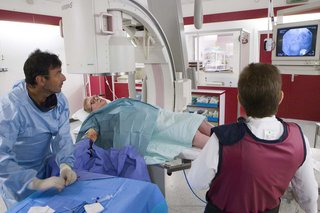Angiography is done in a hospital X-ray or radiology department. It usually takes between 30 minutes and 2 hours, and you can usually go home the same day.
Preparing for angiography
You may be asked to attend a hospital appointment to check you can have angiography.
This may involve:
- being asked about your medical history, including if you have any allergies
- being asked about any medicine you're taking – you'll be told if you need to stop taking it before the test
- having tests to check your general health, including a physical examination and blood test
- discussing the procedure, including what it involves, what the risks are, what you need to do before the test and whether you'd like to have a sedative on the day to help you relax
If you decide to have a sedative, you'll be asked to not eat for a few hours before the test.
You'll also need to arrange for someone to take you home from the hospital because you will not be able to drive yourself home.
The angiography procedure

For the test:
- you'll usually be awake, but general anaesthetic (where you're asleep) may be used for young children
- a small cut is made in the skin over 1 of your arteries, usually near your groin or wrist – local anaesthetic is used to numb the area so it does not hurt
- a long, thin, flexible tube (catheter) is inserted into the artery and is carefully guided to the area being examined – you may feel some pushing and pulling when this is done, but it should not be painful
- a special dye (contrast agent) is injected through the catheter – you may feel warm, flushed and as though you need to pee for a few seconds after this is done
- a series of X-rays are taken as the contrast agent flows through your blood vessels
Sometimes treatment may be done at the same time, such as inserting a balloon or a small tube to open a narrowed artery. This is known as angioplasty.
After the procedure, the catheter is removed and pressure is placed on the cut to stop any bleeding. Stitches are not needed.
After angiography
After the test, you'll be taken to a recovery ward where you'll be asked to lie still for a few hours to prevent bleeding from the cut.
You'll usually be able to go home the same day, although sometimes you may need to stay in hospital overnight.
It may be possible to let you know the results of the test before you go home. However, the X-rays often need to be studied in detail and the results are not available for a few weeks.
While recovering at home:
- rest for the remainder of the day – it's a good idea for someone to stay with you for at least 24 hours in case you have any problems
- eat and drink as soon as you feel ready to – the contrast agent leaves your body in your pee, so drinking plenty of water can help flush it out faster
- you can usually return to most normal activities the next day, although you may need to avoid heavy lifting and strenuous exercise for a few days
You'll probably have some bruising and soreness for at least a few days.
Page last reviewed: 30 January 2023
Next review due: 30 January 2026